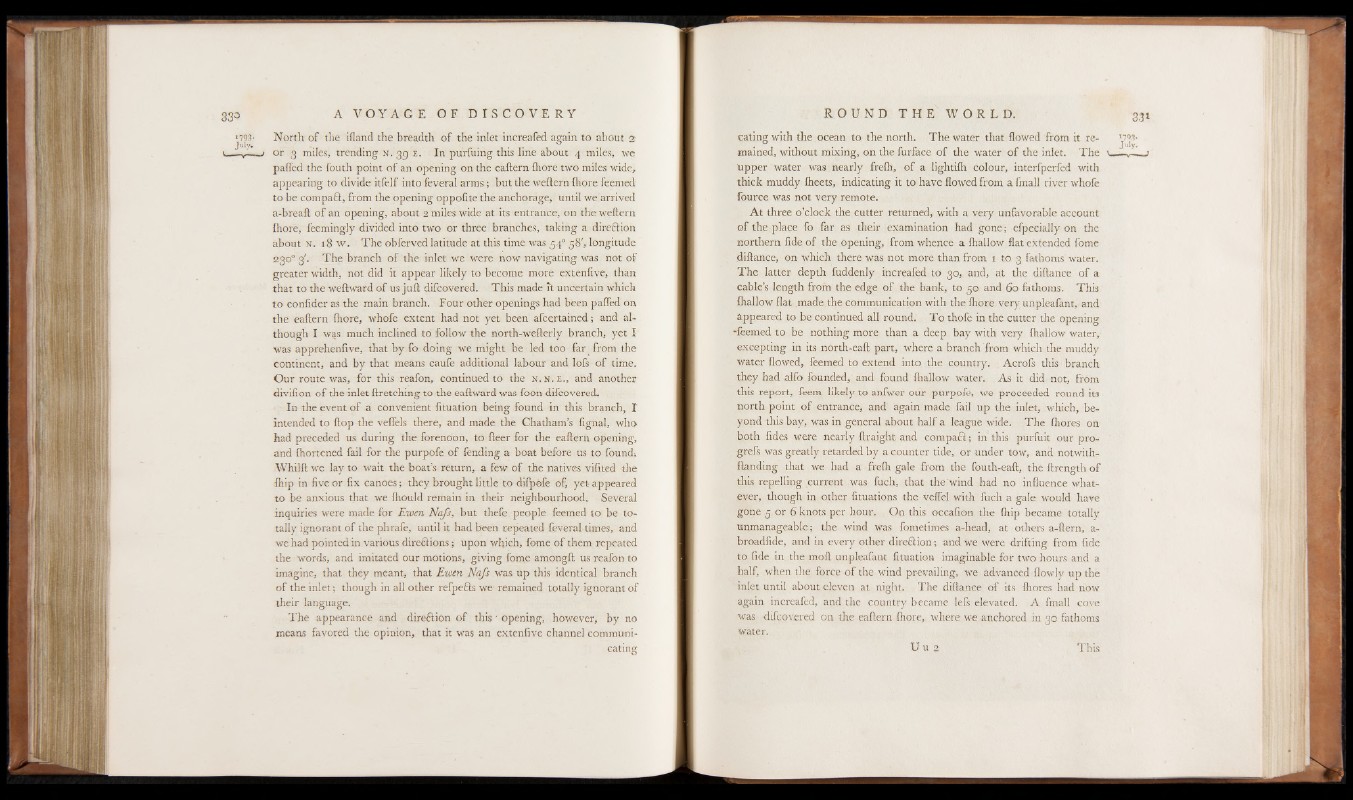
33=
»793- North of the ifland the breadth of the inlet increafed again to about z
< - - ■ or 3 miles, trending N. gg e . In purfuing this line about 4 miles, we
palled the fouth point of an opening on the eaftern Ihore two miles wide,
appearing to divide itfelf into feveral arms; but the weftern Ihore feemed
to be compaft, from the opening oppofite the anchorage, until we arrived
a-breaft of an opening, about 2 miles wide at its entrance, on the weftern
Ihore, feemingly divided into two or three branches, taking a direction
about n . 18 w . The obferved latitude at this time was 540 58', longitude
230° 3'. The branch of the inlet we were now navigating was not of
greater width, not did it appear likely to become more extenfive, than
that to the weftward of us juft difcovered. This made it uncertain which
to conlider as the main branch. Four other openings had been palled on
the eaftern Ihore, whofe extent had not yet been ascertained ; and although
I was much inclined to follow the north-wefterly branch, yet I
was apprehenfive, that by fo doing we might be led too far from the
continent, and by that means caufe additional labour and lofs o f time.
Our route was, for this reafon, continued to the n . n . e ., and another
divifion o f the inlet ftretching to the eaftward was foon difcovered.
In the event of a convenient lituation being found in this branch, I
intended to flop the veflels there, and made the Chatham’s lignal, who
had preceded us during the forenoon, to fleer for the eaftern opening,
and Ihortened fail for the purpofe o f lending a boat before us to found;
Whilft we lay to wait the boat’s return, a few of the natives vilited the
Ihip in five or fix canoes; they brought little to difpofe of; yet- appeared
to be anxious that we Ihould remain in their neighbourhood. Several
inquiries were made for Exam Nafs, but thefe people feemed to be totally
ignorant of the phrafe, until it had been repeated feveral times, and
we had pointed in various direftions; upon which, feme o f them repeated
the words, and imitated our motions, giving fome amongft us reafon to
imagine, that they meant, that Ewen Nafs was. up this identical branch
of the inlet; though in all other refpefts we- remained totally ignorant of
their language.
The appearance and direftion o f this • opening, however, by no
means favored the opinion, that it was an extenfive channel communicating
eating with the ocean to the north. The water that flowed from it re- ’793-
mained, without mixing, on the furface of the water o f the inlet. The > — L—
Upper water was nearly frelh, o f a lightilh colour, interfperfed with
thick muddy Iheets, indicating it to have flowed from a fmall river whofe
fource was not very remote.
A t three o’clock the cutter returned, with a very unfavorable account
o f the place fo far as their examination had gone; efpecially on the
northern fide of the opening, from whence a fhallow flat extended fome
diftance, on which there was not more than from 1 to 3 fathoms water.
The latter depth fuddenly increafed to 30, and, at the diftance of a
cable’s length from the edge of the bank, to 50 and 60 fathoms. This
fhallow flat .made the communication with the fhore very unpleafant, and
appeared to be continued all round. T o thofe in the cutter the opening
-feemed to be nothing more than a deep bay with very fhallow water,
excepting in its north-eaft part, where a branch from which the muddy
water flowed, feemed to extend into the country. Acrofs this branch
they had alfo founded, and found fhallow water. As it did not, from
this report, feem likely to anfwer our purpofe, we proceeded round its
north point of entrance, and again made fail up the inlet, which, beyond
this bay, was in general about half a league wide. The fhores on
both fides were nearly ftraight and compaft; in this purfuit our pro-
grefs was greatly retarded by a counter tide, or under tow, and notwith-
ftanding that we had a frefh gale from the fouth-eaft, the ftrength of
this repelling current was fuch, that the wind had no influence whatever,
though in other fituations the veflel with fuch a gale would have
gone 5 or 6 knots per hour. On this occafion the Chip became totally
unmanageable; die wind was fometimes a-head, at others a-ftern, a-
broadfide, and in every other direftion; and we were drifting from fide
to fide in the mod unpleafant lituation imaginable for two hours and a
half, when the force o f the wind prevailing, we advanced flowly up the
inlet until about eleven at night. The diftance of its fhores had now
again increafed, and the country became lefs elevated. A fmall cove
was difcovered on the eaftern fhore, where we anchored in 30 fathoms
water.
U u 2 This